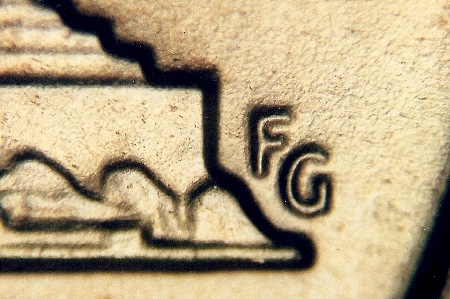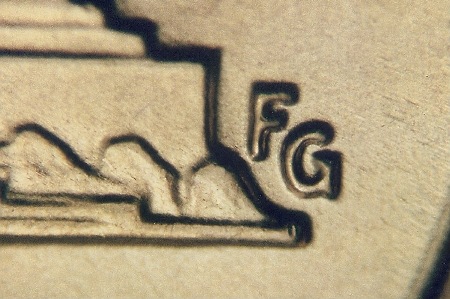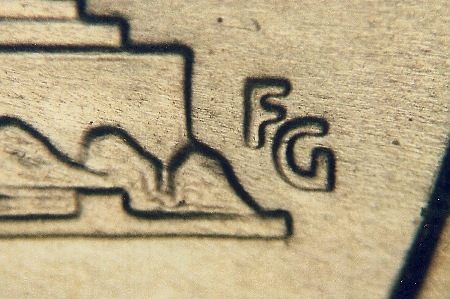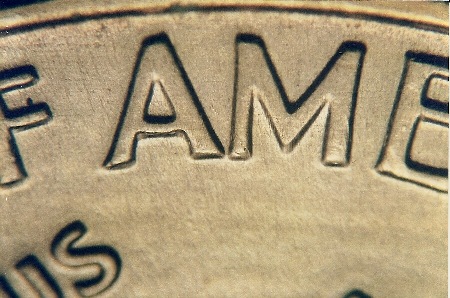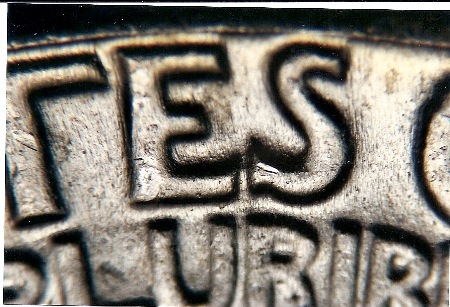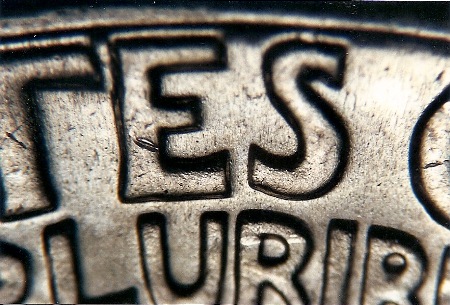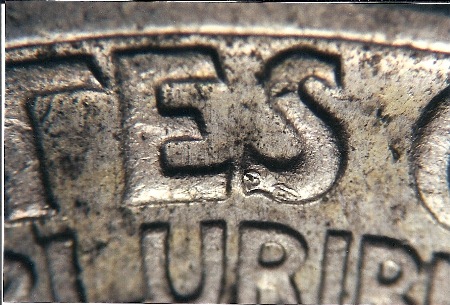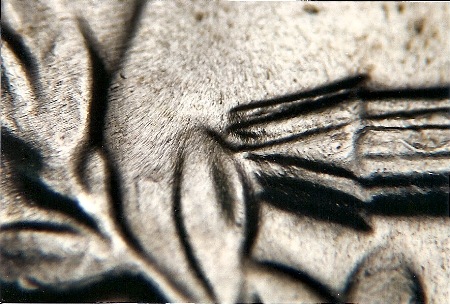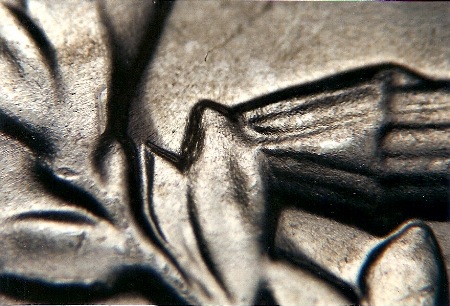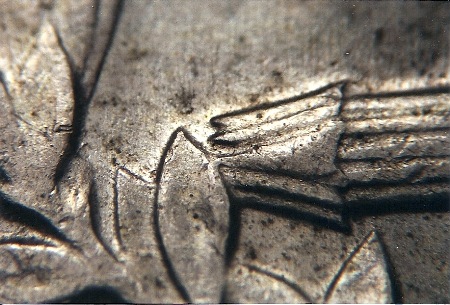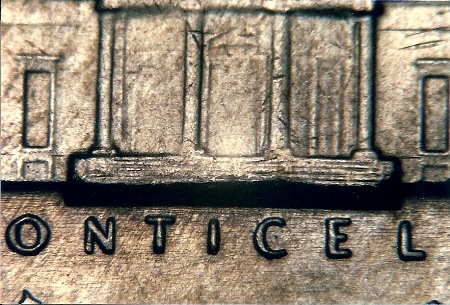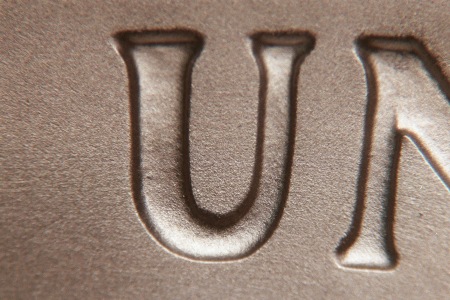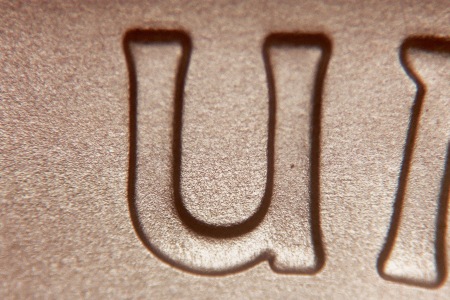


 |
 |
 |
 |
 |
 |
 |
 |
 |
 |
 |
 |
 |
 |
 |
 |
 |
 |
 |
 |
 |
 |
 |
 |
A transitional design variety by definition for the Wexler Die Variety Files is a working die on which the design for a given year was used the year before it was actually meant to be used, or on a working die during a year after it was removed from use. A few examples should get the point across nicely. In 1989 the Mint modified the design on the reverse of the Lincoln Memorial cents creating the 6th Memorial reverse design for the Memorial cent series. In the Wexler Die Variety Files we identify this reverse as Lincoln Memorial Reverse Design #6 (LMRD-006). CONECA identifies this Memorial reverse design as RDV-006. LMRD-006 was used on the Lincoln Memorial cents from 1989 through 1992 where it was used on all circulation strike and all proof cents for those years. It was also used for proof Lincoln cents struck from 1994 through 2008. The normal reverse for the 1988 Lincoln cents was used on all circulation strike and all proof cents from 1986 through 1988. We identify this reverse design as LMRD-005 (CONECA RDV-005). While there are subtle differences throughout the entire reverse between the design used in 1988 (LMRD-005) and the modified design introduced in 1989 (LMRD-006), the easiest place to spot the difference is on the designer’s initials. The new modified 1989 design has a distinct serif at the top left side of the vertical bar of the G in FG where the 1988 design does not have this serif. On the modified 1989 design the vertical bar of the G in FG extends down below the lower right curve of the G. It does not do that on the 1988 design.
These are the designer’s initials on the reverse of the 1988 Lincoln cents. Note that the top left side of the vertical bar of the G does NOT have a serif. Also note that the vertical bar of the G does NOT extend below the lower right curve of the G. This reverse was the intended design for all Lincoln cents struck from 1986 through 1988 and is identified in our files as LMRD-005.
Here we see the designer’s initials on the new modified reverse design on the 1989 Lincoln cents. There is a distinct serif on the top left side of the vertical bar on the G. Also, the vertical bar of the G extends below the lower right curve of the G. This reverse was the intended design for all Lincoln cents struck from 1989 through 1992 and then for all proof cents struck from 1994 through 2008. A ripple of excitement went through the hobby when a 1988 Lincoln cent was found with the modified reverse design introduced in 1989. Either someone accidentally grabbed some reverse dies intended for the 1989 Lincoln cents and used them at the end of 1988, or they ran out of 1988 Lincoln cent reverse dies at the end of 1988 and intentionally grabbed a few dies with the 1989 reverse hoping that no one would notice. The result was a transitional reverse design variety for the 1988 Lincoln cents that could be described as a “1988 Lincoln cent with the reverse of 1989.” Since that initial discovery seven different transitional working dies have been identified for the 1988 P-Mint cents in the Wexler Die Variety Files. They are identified as 1988 1¢ WTRD-001 through WTRD-007. The number of affected working dies is monitored to determine the relative scarcity of the variety. Since each circulation strike working die yields about one million coins, if no other 1988 P-Mint transitional design dies are identified, we can estimate the mintage of the 1988 P-Mint transitional design coins at about 7 million coins. The total mintage for the 1988 P-Mint Lincoln cents was 6,092,810,000 coins. Some quick math tells us that approximately 1 in every 870 P-Mint 1988 Lincoln cents will have the transitional reverse design making them quite scarce. That discovery got people searching their Lincoln cents a lot more closely. Not long after that discovery, a 1988-D Lincoln cent with the reverse of 1989 was also found. To date, eleven different 1988-D working dies have been identified with the transitional reverse design. This would yield an estimated mintage of 11 million transitional design coins out of a total mintage of 5,253,740,443 coins for the 1988-D cents. This translates to 1 in every 478 D-Mint cents for 1988 with the transitional reverse design making them a bit easier to find than the P-Mint version. In 1993 the Mint modified the Lincoln Memorial reverse yet one more time. The new design for 1993 gave us designer’s initials that were very similar to those seen on the normal 1988 reverse Lincoln cents. The serif at the top of the vertical bar on the G of FG was no longer there. Also, the vertical bar of the G did not extend below the lower right curve of the G on this new design for 1993, again just like on the normal 1988 reverse.
This is the FG on the reverse design intended for all Lincoln cents (circulation strike and proof strike) struck from 1989 through 1992 (LMRD-006). This reverse design was also the intended design for all proof cents struck from 1994 through 2008.
This is the new FG introduced on the reverse of the 1993 Lincoln cents (LMRD-007). It was the design intended for use on all 1993 coins (circulation strikes and proofs), and on all circulation strike cents from 1994 through 2008. There was, however, a very significant difference between the design used from 1989 through 1992 and the new design introduced in 1993. On the new 1993 reverse design the bottoms of the A and M in AMERICA are almost touching. All previous reverse designs had a significant space between the bottoms of the A and M.
This is the AM in AMERICA on the reverse design intended for all Lincoln cents (circulation strike and proof strike) struck from 1989 through 1992 (LMRD-006). This reverse design was also the intended design for all proof cents struck from 1994 through 2008. Note the separation between the bottoms of the A and M. It has frequently been referred to as the “Wide AM” reverse.
Here we see the AM in AMERICA on the reverse of the 1993 Lincoln cents (LMRD-007). It was the design intended for use on all 1993 coins (circulation strikes and proofs), and on all circulation strike cents from 1994 through 2008. The bottoms of the A and M are almost touching. It has frequently been referred to as the “Close AM” reverse. Not long after the discovery of the transitional design cents for 1988 and 1988-D, a 1992-D Lincoln cent was found with the reverse design introduced on the 1993 Lincoln cents. This was followed shortly thereafter by the discovery of a 1992 P-Mint Lincoln cent with the 1993 reverse design. We have examined a specimen of the 1992-D Transitional Reverse cent, but we have not yet had an opportunity to examine a specimen of the 1992 P-Mint variety. If you have one, we would welcome the opportunity to shoot photos of it for our files. To date only one working die is known to have the transitional reverse design for the 1992 P-Mint cents and only one working die is known to be affected for the 1992 D-Mint cents. This would make the 1992 and 1992-D transitional cents far rarer than their 1988 counterparts. Other examples of Transitional Design Varieties are known for the 20th century coinage. From 1932 through 1964 the Washington quarters had one design for the reverse of the circulation strike quarters frequently referred to as the “Type A” reverse (WQRD-001 in the Wexler Files) and a slightly different design for the reverse of the proof quarters which is frequently referred to as the “Type B” reverse (WQRD-002 in the Wexler Files). In 1965 the Mint introduced a design modification for the reverse of the circulation strike quarters which came to be known as the Type C Reverse (WQRD-003).
This is the ES on STATES on the Type A Washington Quarter reverse which was used on circulation strike quarters through 1964. Note how close together the bottoms of the E and S in STATES are.
This is the ES on STATES on the Type B Washington Quarter reverse which was used on proof strike quarters through 1964. Note how the bottoms of the E and S of STATES are much more widely separated.
This is the ES in STATES on the Type C Washington Quarter reverse that was introduced for the circulation strike quarters starting in 1965. The separation between the bottoms of the E and S in STATES are wider than that seen on the Type A reverse, but not as wide as that seen on the Type B reverse.
On the Type A reverse intended for circulation strike quarters through 1964, the top of the leave to the left of the arrowhead points is weak and ends below the top arrowhead point.
This is the same area, but on the Type B reverse which was intended for proof coins struck through 1964. The top of the leave is bold and entends above the point of the top arrowhead.
On the Type C reverse for the Washington quarters which was introduced in 1965 the leave to the left of the arrowheads is sharp and well defined. The tip of the leave is slightly below the tip of the top arrowhead. At the moment two working dies for the 1964-D Washington quarters are known to have the Type C reverse which was not supposed to make its appearance until 1965. How or why these Type C reverse dies made it into production at the Denver Mint in 1964 is something we will never know, but it did give us a great transitional design variety that we have listed in our files as 1964-D 25¢ WTRD-001. You may have one of these in your collection and not even known it. In 1939 the Mint modified the reverse design of the Jefferson nickel so that the 1939 Jefferson nickels come in two varieties. Variety 1 is usually described as the “Reverse of 1938” (Wexler JNRD-001) and is best recognized by steps on Monticello that are not well defined and sometimes described as “wavy”. Variety 2 is usually described as the “Reverse of 1940” (Wexler JNRD-002) and it has very sharp, well defined steps on Monticello. Both of these varieties are normal for the 1939 Jefferson nickels including the 1939 proof nickels, although the proof nickels with the reverse of 1940 are such scarcer than those with the reverse of 1938.
Here we see the steps on Monticello as they appear on all 1938 Jefferson nickels and some 1939 Jefferson nickels from all three Mints including proofs. For the 1939 Jefferson nickels with these steps the variety is referred to as the "Reverse of 1938" and sometimes simply as "Variety 1."
These are the stronger, bolder steps on Variety 2 nickels for 1939. The Mint switched to this design sometime in 1939 creating two different reverse varieties for the 1939 nickels. This reverse can also be found for 1939 nickels from all three Mints as well as on proofs. This reverse is frequently referred to as the "Reverse of 1940." The transitional aspect enters in 1940 due to the discovery of a 1940 Jefferson nickel proof die with the “Reverse of 1938.” We have this variety listed as 1940 5¢ Pr WTRD-001. See the transitional listings for photos of the die markers for this variety. In the May 5, 2008 issue of Coin World, staff writer Paul Gilkes announced the discovery of 2008-W Uncirculated 1-ounce American Eagle Silver Dollar coins that had the reverse of 2007. The Mint modified the reverse design of the American Eagle Silver Dollars in 2008. One of the easiest ways to tell the difference between the “Reverse of 2007” and the new modified “Reverse of 2008” is on the U of UNITED. The “Reverse of 2007” has a “Plain U” that is wider on the left than it is on the right. The “Reverse of 2008” has a strong “spur” on the bottom right side of the U. It also has equal thickness on both the left and right sides of the U. This is the "Reverse of 2007" found on some 2008-W Silver Eagle $1 coins. Note there is no "spur" on the lower right U and the right side of the U is thinner than the left. This is the transitional reverse design for the 2008-W Silver Eagle dollar coins. This is the "normal" reverse for the 2008-W Silver Eagle $1 coins. Note the strong spur on the bottom right side of the U and both sides of the U are the same thickness. Personally we are not aware of any other transitional design varieties for the 20th century coinage and welcome the reports of any suspected varieties of this type that you may have. Going through A Guide Book of United States Coins (The Red Book) we found mention of 1796 Large Cents with the reverse of 1794, 1796 Large Cents with the reverse of 1795, 1796 Large Cents with the reverse of 1797, 1798 Large Cents with the reverse of 1796. They sound like classic examples of transitional design varieties. We didn’t have the time to investigate any further than that, but surely other varieties exist. Go To: | ||


